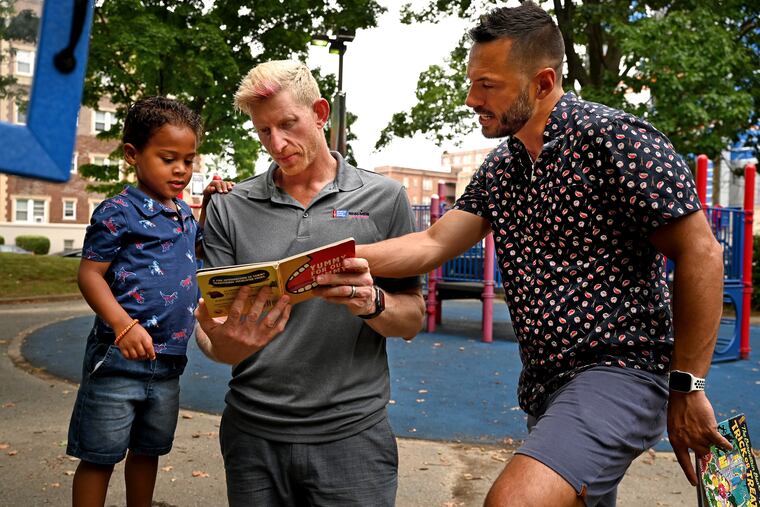Bad sunburn in childhood can lead to skin cancer later
Intermittent sunburn during childhood can set the stage for future skin cancers. The risk of developing skin cancer doubles with five sunburns — or just one blistering sunburn.

CJ Weiss at first brushed off the bump on his leg. He was prone to skin tags and moles, for which he saw a dermatologist annually. He’d ask about it at his next appointment, in September. But by then, the lump had grown to a half-inch mass that was blistering and bleeding.
The doctor removed it and quickly determined that it was melanoma, the most deadly type of skin cancer. A biopsy determined that it had already spread to his lymph nodes and groin — a stage 4 diagnosis.
He needed surgery, followed by four months of infusions. Three years later, he still goes for biannual ultrasounds and PET scans to search for cancer that may have returned.
Now 43 and living in West Philadelphia, Weiss and his husband, Tyler Groll, diligently slather their 3-year-old son with sunscreen anytime he goes outside.
“It is worth the kicking and screaming to protect his future,” Weiss said.
The blistering sunburns Weiss earned growing up as a fair-skinned towhead playing with friends and mowing lawns shirtless had almost certainly been the catalyst for his cancer, his doctor told him.
Skin cancer is by far the most common of all cancers, according to the American Cancer Society. Melanoma accounts for only about 1% of skin cancers but causes a majority of skin cancer deaths.
Between 2008 and 2018, new cases of malignant melanoma — the type caused by sun exposure — increased by about 1.2% a year, according to data released in May by the Centers for Disease Control and Prevention. At the same time, deaths declined with increased awareness of the risks and warning signs of melanoma, such as abnormally shaped or colored moles, and as cases were caught earlier.
But too often, people don’t think about how to protect themselves until much of the damage to their skin is already done. Intermittent sunburn during childhood can set the stage for future skin cancers. The risk of developing skin cancer doubles with five sunburns — or just one blistering sunburn — according to the Skin Cancer Foundation, a nonprofit organization focused on prevention, detection and treatment.
Like most forms of cancer, the risk of skin cancer increases with age, but it is also among the most common cancers in young adults, especially women.
“I try to explain, especially to teenagers and young adults, that sun exposure is also going to age you more prematurely,” said Robin Levin, a dermatologist at Virtua Health and South Jersey Skin Care & Laser Center in Mount Laurel.
Sun protection 101
Kids get sun exposure every day, even when it’s cloudy and in the winter. In other words, don’t stash your sunscreen away with the beach toys — apply it year-round.
“Be careful on a cloudy day, especially in the spring when it starts to get warm and people think they don’t need sunscreen on,” said Alanna Kramer, medical director at St. Christopher’s Pediatric Associates-Northeast Pediatrics. “That’s when we often see kids get really sunburned.”
» READ MORE: Best sunscreen tips a dermatologist wants you to know
Keep kids younger than 6 months out of direct sunlight completely, she said. Early-morning or evening strolls are safest, avoiding the brightest sun hours, which are usually between 10 a.m. and 4 p.m.
Dress them in long-sleeved cotton shirts and pants to help protect their skin and keep them under a stroller top or umbrella. Tighter woven fabric and darker colors, which may feel less comfortable in the heat, are more protective than a flimsy white T-shirt.
Umbrellas, hats with a three-inch brim, and sun blocking fabric can give older children and adults extra protection. Sunglasses are important to protect kids’ eyes.
And, of course, wear sunscreen.
How to choose a sunscreen
But with so many lotions, creams, sprays and sticks all promising to protect children, how do you choose?
Pick a broad spectrum sunscreen — meaning it guards against both UVA and UVB rays — with SPF of at least 30, Levin said.
More expensive isn’t necessarily better. In fact, Consumer Reports includes less expensive drugstore brands in its list of top performers.
Although sprays may be easier to put on, you’re more likely to miss spots and the coverage can be uneven, so lotions may be safer, Kramer said.
And don’t forget to reapply, at least every two hours and sooner if you are in water or sweating. If you find you have a partial lotion bottle left over from last summer, be sure to check the expiration date, as you would for any medication.
“If it’s expired, get a new one on a yearly basis,” she said.
Sunscreen isn’t everything
While white people are 30 times more likely to get skin cancer compared with Black people, skin cancer affects all races and ethnicities.
But when people of color develop melanoma, it is almost always “acral melanoma,” which develops in parts of the body that aren’t exposed to sun, such as nail beds and soles of feet. This type of melanoma is rare and is not caused by UV exposure, which means sunscreen won’t help prevent it.
If caught early, melanoma is highly treatable and has a five-year survival rate of 93%, according to the American Cancer Society.
Vigilance to skin changes is critical for people with dark skin, but important for everyone.
That’s why Levin recommends establishing healthy habits early. Begin scheduling annual visits to the dermatologist when kids become teenagers, so they can learn more about what to look for on their own bodies and catch irregularities early.
“Skin cancer can be very silent,” Levin said. “You may not realize it’s there.”